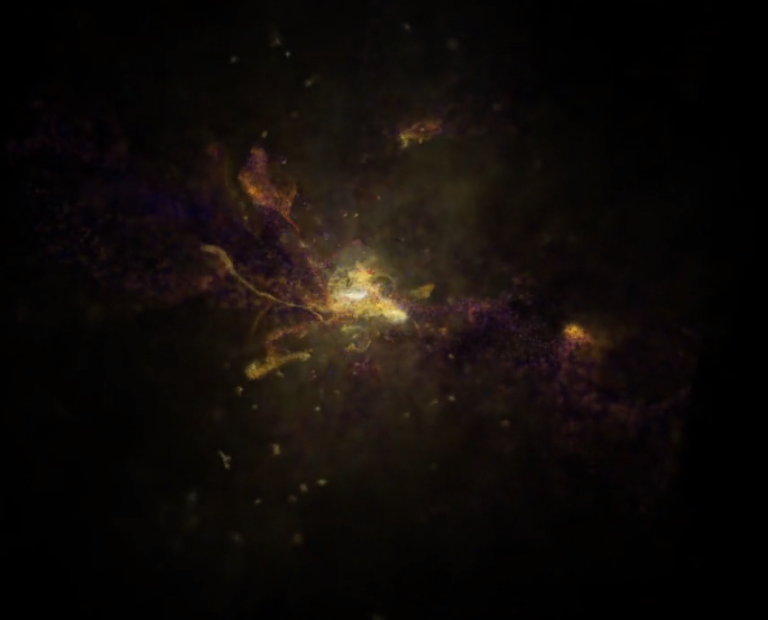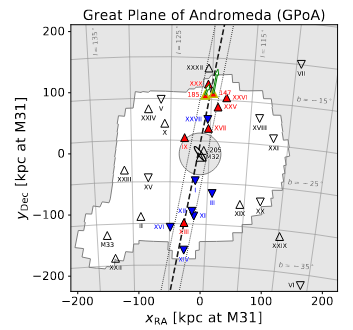Are satellite galaxies “aligned” against the current cosmological paradigm?
Imagine you are enjoying a peaceful summer evening at the shore of the Mediterranean Sea. Not far from you, some kids are piling up sand with a shovel. They do not care about the shape the pile is taking, so one would expect just an amorphous pile of sand. To your astonishment, that is not the case, a long and neat wall is surprisingly built. Of course, this is just a silly example, but what would you think if I tell you that something ‘similar’ is happening in our Cosmic Vicinity?
According to the current cosmological paradigm, the lambda cold dark matter (ΛCDM) model, matter is distributed in the Universe forming a sponge-like net characterised by walls and filaments (regions where matter abounds), as well as voids (regions depleted of matter). Indeed, this is exactly what we observe, which is one of the main predictions from this model. But this is just the beginning. As this large scale structure forms over time, galaxies are born in the densest parts through the violent merging and accretion of smaller systems, the dwarf galaxies (see figure 1). In this scenario, some dwarf galaxies have already been disrupted and their debris now form part of massive galaxies. However, some others still survive, orbiting their massive host galaxy.

Two of these massive galaxies are the Andromeda galaxy and our own galaxy, the Milky Way. These galaxies, as expected, harbor a myriad of dwarf galaxies around them. However, they seem peculiar… let’s go back to my silly example. If kids throw randomly sand in a pile, that pile would not acquire a well-defined shape, but rather an amorphous shape. Similarly, if matter and dwarf galaxies are accreted to a central galaxy violently with no privileged direction, the surviving dwarf galaxies should not be ordered in space, but chaotically distributed. In fact, this is another prediction from the ΛCDM cosmological model, dwarf galaxies around massive systems should display a nearly isotropic distribution (similar properties no matter where you look). However, both galaxies, not only host dwarf galaxies that are distributed in a plane, they also rotate around the same axis (as planets do around the Sun)!1 2
Given the cosmological implications of these findings, more and more effort is put to try to shed some light on the topic. In a recent study recently published by the Astrophysical Journal (ApJ), a group of scientists from the Leibniz Institute for Astrophysics, analysed the motions around the Andromeda galaxy of two of its most important satellites, NGC185 and NGC147 3. Both dwarf galaxies, located right in the plane, had uncertain movements that have been precisely measured now by this team. Both systems clearly rotate with the rest of satellites in the so-called Great Plane of Andromeda (see Figure 2). As evidence piles up, an important question arises: Is the current cosmological model wrong?

Some scientists venture to say that our cosmic neighbourhood is atypical, and thus, should not be used to test cosmology. But, what would happen if we move away from our local neighbourhood? This is the question that motivated, some years ago, a group of astrophysicists to explore the satellite population of a (not-so-local) giant elliptical galaxy, Centaurus A 4. What did they discover? What do you think? Once again, its dwarf satellites orbit orderly, forming a plane of satellites. After all, it seems that corotating satellite systems are more common in the universe than we thought. Fortunately, we have models. We can simulate toy universes within computers. What do cosmological simulations tell us about this problem?
Well, at first sight, the situation seems to worsen. Comparisons with the IllustrisTNG simulation (one of the vast simulations of large-volume universes able to simulate dwarfs orbiting massive galaxies) show that galaxies hosting planes of satellites are indeed rare, only 1 in 1000 show similar characteristics to what has been observed already three times, in the Milky Way, Andromeda, and Centaurus A.
Fortunately, there appears to be light at the end of the tunnel. As better and more detailed simulations appear (all within the ΛCDM paradigm) with better prescriptions on how to simulate visible matter (as well as dark matter) planes of satellites are starting to become more common as well in simulations 5. We said that, according to ΛCDM, matter is distributed in walls and filaments, right? Well, those walls are indeed planar structures and accreted satellites should follow such large scale structure. If this ordered accretion is maintained through time and at a sustainable pace (not extremely violent), then you can end up with a host galaxy surrounded by a plane of co-rotating satellites (as observed in the Milky Way, Andromeda, and Centaurus A).
So, after all, it seems that our precious ΛCDM cosmological model, that is able to reproduce so many observational aspects, will survive this tough test as well. In fact, we can consider this model as one of the huge achievements of modern astrophysics. However, it is (and it will be) constantly being challenged,… so far, mission accomplished! Let’s see what new challenges and tests ΛCDM will have to endure!
References
- Kroupa, P. ; Theis, C. ; Boily, C. M. (2005) “The great disk of Milky-Way satellites and cosmological sub-structures” Astronomy and Astrophysics, doi: 10.1051/0004-6361:20041122. ↩
- Ibata, Rodrigo A. ; Lewis, Geraint F. ; Conn, Anthony R. et al. (2013) “A vast, thin plane of corotating dwarf galaxies orbiting the Andromeda galaxy” Nature, doi: 10.1038/nature11717. ↩
- Pawlowski, Marcel S. ; Sohn, Sangmo Tony (2021) “On the Co-Orbitation of Satellite Galaxies Along the Great Plane of Andromeda: NGC 147, NGC 185, and Expectations from Cosmological Simulations” Astrophysical Journal, doi: 10.3847/1538-4357/ac2aa9. ↩
- Müller, Oliver; Pawlowski, Marcel S.; Jerjen, Helmut; Lelli, Federico (2018) “A whirling plane of satellite galaxies around Centaurus A challenges cold dark matter cosmology” Science, doi: 10.1126/science.aao1858. ↩
- Santos-Santos, I. ; Artal, H. ; Domínguez-Tenreiro, R. et al. “Understanding planes of satellites”, IAU proceedings, doi: 10.1017/S1743921318006191 ↩